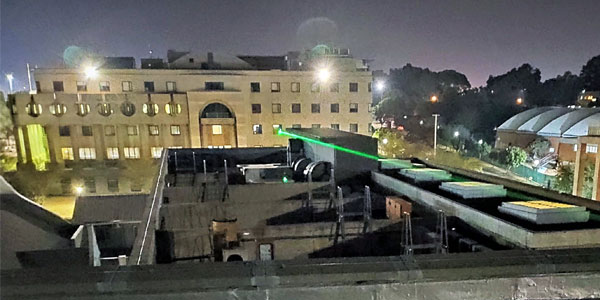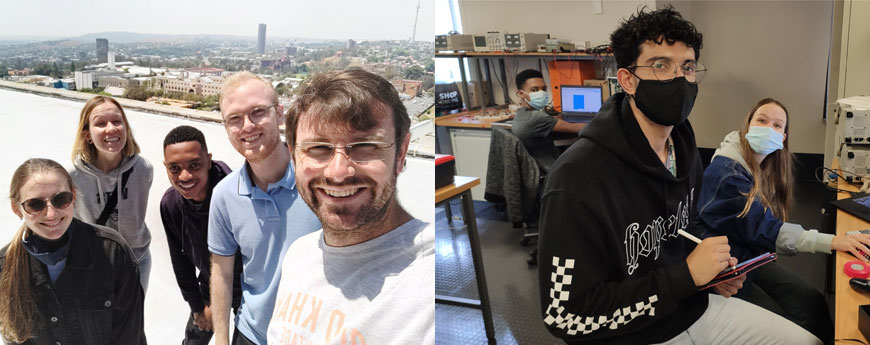Lighting up the digital divide with ‘Fibre, Before the Fibre’
- Wits University
Wits leads efforts to develop low-cost, long-range free-space optics that can connect informal settlement communities to high-speed internet.
Imagine beaming light from a fibre-connected suburban home to a 3D-printed wireless communication system to a school in an informal settlement across the road, providing learners with instant high-speed, reliable internet access.
This is how the new Optical Communications Laboratory (OC Lab) in the School of Electrical and Information Engineering at the University of the Witwatersrand (Wits University) in Johannesburg plans to bridge the peri-urban digital divide in South Africa.
A two-year project is underway to demonstrate the use of wireless optical technologies to provide flexible and rapidly deployable communications infrastructure that researchers say will be a ‘fibre before the fibre’ solution for communities not yet connected to existing fibre infrastructure.
The ‘Fibre Before the Fibre Project’ is a collaboration between Wits University in South Africa and the Universities of Glasgow and Aston in the UK. It was conceptualised before the 沙巴体育官网_2024欧洲杯博彩app@ pandemic that has dramatically worsened the digital divide due to the increased reliance on electricity and communication technologies for remote learning, working, and accessing health care services.
Lead investigator Dr Mitchell Cox, co-founder of the OC Lab at Wits University, says: “In cities like Johannesburg there’s a stark contrast between informal settlements that don’t have fibre and nearby affluent suburbs, often just across the road, that do.”
While there are over 50 million smartphones with access to the internet in use in South Africa, Cox says data costs are too high and mobile internet is not fast enough to provide an entire building, such as a school with connectivity suitable for streaming video, for example.
“What are the opportunities if we could simply ‘light up’ that digital divide?” asks Cox. “Access to the internet enables children to broaden their horizons and expand their curiosity: something that I believe leads to much-needed scientists, engineers and entrepreneurs."
How it will work
The OC Lab, together with the Structured Light Laboratory headed by Professor Andrew Forbes at Wits University, and the UK collaborators, Professor Martin Lavery (Glasgow) and Professor Andrew Ellis (Aston), have over the past several years been researching and developing low-cost, long-range, high-speed wireless optical communication technologies.
“We are now developing a low-cost, 3D-printed wireless communication system using off-the-shelf components as far as possible. These devices will link anchor sites, such as schools, clinics or police stations, via a wireless optical line-of-site signal to nearby fibre-sources in affluent suburbs that are within about a kilometre of the anchor sites,” explains Cox.

Powerful partners
The ability to power the system is key to the sustainability of this Project. The Fibre Before the Fibre Project has teamed up with another innovative project also developed in the School of Electrical and Information Engineering.
Professor Willie Cronje and his team of PhD students have developed the PeCo Grid, an affordable off the grid energy system that could potentially power whole villages. The home-based electrical grid solution can easily integrate multiple energy sources – from solar panels to batteries. The commercialisation of the project with industry partners has led to a spin-off company, PeCo Power, that designs, manufactures, and distributes smart solar products for household electrification.
Cox explains, “through our partnership with PeCo Power, we’ve come to realise that reliable electricity is a scarce resource even for schools in peri-urban areas. The PeCo system is a cost-effective and reliable way to power our system, while providing any excess to the school itself.”
A lifeline for communities
Rapid urbanisation is occurring across many developing nations, and with most of the world’s population predicted to be living in an urban environment by 2050, projects such as the Fibre Before the Fibre Project will be a lifeline for many evolving informal settlements.
It is for this reason that the Royal Academy of Engineering in the UK has provided funding of R1.7-million for the Project.
“This is enough money for us to build a demonstrator system, fund a few postgraduate students and to evaluate the opportunities and challenges of our idea. Rolling out telecommunications infrastructure is an enormous and expensive exercise, and our intention is not to replace what the service providers do, but rather to try leverage what’s existing for maximum impact. Hopefully this is just the start of something awesome!” says Cox enthusiastically.

Project stages
The Fibre Before the Fibre Project will roll out in phases, and a range of key activities are planned, says Cox.
Recently, the research team met with a diverse group of stakeholders to gather insights about the social and technical requirements, as well as educational opportunities afforded by the system. Design and construction of a suitable prototype are now underway, and in 2022 the team hopes to deploy the prototype linking a currently unconnected school to nearby conventional fibre infrastructure.
“We will measure the system performance, usage and social impact of the link over an extended period. This information will help us to develop a roadmap to deploy this technology in informal settlements globally,” says Cox.
